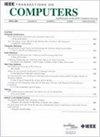Distributed Sketch Deployment for Software Switches
IF 3.6
2区 计算机科学
Q2 COMPUTER SCIENCE, HARDWARE & ARCHITECTURE
引用次数: 0
Abstract
Network measurement is critical for various network applications, but scaling measurement techniques to the network-wide level is challenging for existing sketch-based solutions. In software switches, centralized deployment provides low resource usage but suffers from poor load balancing. In contrast, collaborative measurement achieves load balancing through flow distribution across software switches but requires high resource usage. This paper presents a novel distributed deployment framework that overcomes the limitations above. First, our framework is lightweight such that it splits sketches into segments and allocates them across forwarding paths to minimize resource usage and achieve load balancing. This also enables per-packet load balancing by distributing computations across software switches. Second, through a novel collaborative strategy, our framework achieves finer-grained flow distribution and further optimizes load balancing. Third, we further optimize load balancing by eliminating the mutual influence among forwarding paths. We evaluate the proposed framework on various network topologies and different sketches. Results indicate our solution matches the load balancing of collaborative measurement while approaching the low resource usage of centralized deployment. Moreover, it achieves superior performance in per-packet load balancing, which is not considered in previous deployment solutions.求助全文
约1分钟内获得全文
求助全文
来源期刊

IEEE Transactions on Computers
工程技术-工程:电子与电气
CiteScore
6.60
自引率
5.40%
发文量
199
审稿时长
6.0 months
期刊介绍:
The IEEE Transactions on Computers is a monthly publication with a wide distribution to researchers, developers, technical managers, and educators in the computer field. It publishes papers on research in areas of current interest to the readers. These areas include, but are not limited to, the following: a) computer organizations and architectures; b) operating systems, software systems, and communication protocols; c) real-time systems and embedded systems; d) digital devices, computer components, and interconnection networks; e) specification, design, prototyping, and testing methods and tools; f) performance, fault tolerance, reliability, security, and testability; g) case studies and experimental and theoretical evaluations; and h) new and important applications and trends.
 求助内容:
求助内容: 应助结果提醒方式:
应助结果提醒方式:


